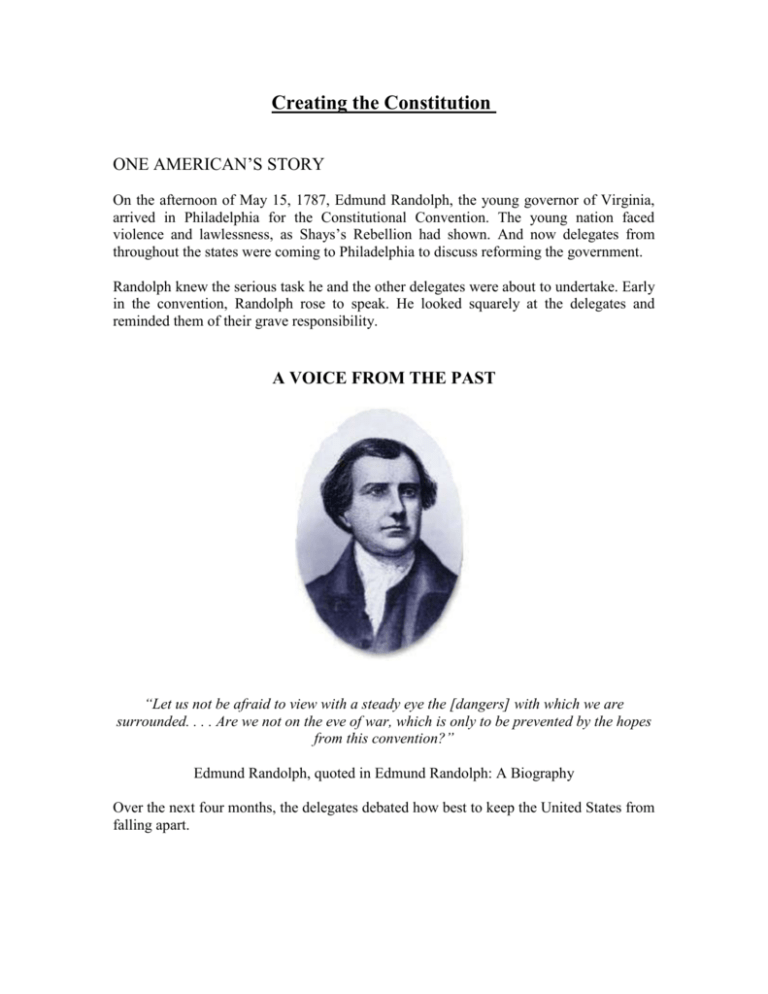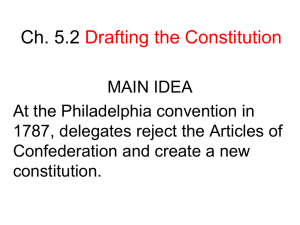Creating the Constitution
advertisement

Creating the Constitution ONE AMERICAN’S STORY On the afternoon of May 15, 1787, Edmund Randolph, the young governor of Virginia, arrived in Philadelphia for the Constitutional Convention. The young nation faced violence and lawlessness, as Shays’s Rebellion had shown. And now delegates from throughout the states were coming to Philadelphia to discuss reforming the government. Randolph knew the serious task he and the other delegates were about to undertake. Early in the convention, Randolph rose to speak. He looked squarely at the delegates and reminded them of their grave responsibility. A VOICE FROM THE PAST “Let us not be afraid to view with a steady eye the [dangers] with which we are surrounded. . . . Are we not on the eve of war, which is only to be prevented by the hopes from this convention?” Edmund Randolph, quoted in Edmund Randolph: A Biography Over the next four months, the delegates debated how best to keep the United States from falling apart. A Constitutional Convention Is Called In 1786, a series of events began that would eventually lead to a new form of government for the United States. In September of that year, delegates from five states met in Annapolis, Maryland, to discuss ways to promote trade among their states. At the time, most states placed high taxes on goods from other states. The delegates believed that creating national trade laws would help the economies of all the states. Making such changes required amending the Articles of Confederation, because the national government had been granted no power to regulate trade among the states. The Annapolis delegates, led by Alexander Hamilton of New York, called for the states to send representatives to Philadelphia the following May to discuss such changes. At first, many Americans doubted that the national government needed strengthening. But news of Shays’s Rebellion in late 1786 and early 1787 quickly changed many people’s minds. Fearing that rebellion might spread, 12 states sent delegates to the meeting in Philadelphia in the summer of 1787. Only Rhode Island refused to participate. The Convention’s Delegates The 55 delegates to the Constitutional Convention, as the Philadelphia meeting became known, were a very impressive group. About half were lawyers. Others were planters, merchants, and doctors. Three-fourths of them had been representatives in the Continental Congress. Many had been members of their state legislatures and had helped write their state constitutions. Along with other leaders of the time, these delegates are called the Founders, or Founding Fathers, of the United States. America’s most famous men were at the Constitutional Convention. George Washington, the hero of the Revolution, came out of retirement for the meeting. Benjamin Franklin, the famous scientist and statesman, lent his wit and wisdom to the convention. One of the ablest delegates was James Madison. Madison had read more than a hundred books on government in preparation for the meeting. When Thomas Jefferson, serving as ambassador to France, read the list of delegates, he wrote, “It is really an assembly of demigods.” Not everyone was at the Constitutional Convention. Thomas Jefferson and John Adams were overseas at their diplomatic posts. But they wrote home to encourage the delegates. Others had a less positive outlook on the convention. For example, Patrick Henry, who had been elected as a delegate from Virginia, refused to attend. He said he “smelled a rat in Philadelphia, tending toward monarchy.” Also, the convention did not reflect the diverse U.S. population of the 1780s. There were no Native Americans, African Americans, or women among the delegates. The nation’s early leaders did not consider these groups of people to be citizens and did not invite any of them to attend. However, the framework of government the Founders established is the very one that would eventually provide full rights and responsibilities to all Americans. The Delegates Assemble Most of the delegates arrived at the Constitutional Convention without a clear idea of what to expect. Some thought they would only draft amendments to the Articles of Confederation. Others thought they would design an entirely new plan for the government. But they all agreed that the government should protect people’s rights. Back in 1776, many Americans thought that government was the main threat to people’s rights. But by 1787, many realized that the people often came into conflict and needed a government that could maintain order. As a result, the government had to be strong enough to protect people’s rights but not too strong to be controlled. Madison later wrote about this problem. A VOICE FROM THE PAST If men were angels, no government would be necessary. If angels were to govern men, neither external nor internal controls on government would be necessary. In framing a government which is to be administered by men over men, the great difficulty lies in this: you must first enable the government to control the governed; and in the next place oblige it [the government] to control itself. James Madison, The Federalist “Number 51” This was the challenge that faced the delegates: how to set up a strong but limited federal government. By May 25, 1787, at least two delegates from each of seven states had arrived in Philadelphia. With 29 delegates in attendance, the convention was officially under way. The Convention Begins The first order of business was to elect a president for the convention. Robert Morris of Pennsylvania nominated George Washington. No American was more respected or admired than Washington. Every delegate voted for him. Washington’s quiet and dignified leadership set a solemn and serious tone for the convention. At their next meeting, the delegates decided on the rules for the convention. They wanted to be able to consider all ideas and to be able to change sides in any debate. They did not want to be pressured by the politics of the day. For these reasons, they decided that their discussions would remain secret. To ensure privacy, the windows in their meeting room were kept shut even though it was summer. Guards were posted outside the door. Whenever the door was opened, the delegates stopped talking. With the secrecy rule approved, they got down to business. The Virginia Plan On May 29, the delegates began the real work of designing a new national government. Presiding over the convention, George Washington recognized Edmund Randolph as the first speaker. Randolph offered a plan for a whole new government. The plan became known as the Virginia Plan. Madison, Randolph, and the other Virginia delegates had drawn up the plan while they waited for the convention to open. The Virginia Plan proposed a government that would have three branches. The first branch of government was the legislature, which made the laws. The second branch was the executive, which enforced the laws. The third branch was the judiciary, which interpreted the laws. The Virginia Plan proposed a legislature with two houses. In both houses, the number of representatives from each state would be based on the state’s population or its wealth. The legislature would have the power to levy taxes, regulate commerce, and make laws “in all cases where the separate states are incompetent [unable].” The Virginia Plan led to weeks of debate. Because they had larger populations, larger states supported the plan. It would give them greater representation in the legislature. The smaller states opposed this plan. They worried that the larger states would end up ruling the others. Delaware delegate John Dickinson voiced the concerns of the small states. A VOICE FROM THE PAST “Some of the members from the small states wish for two branches in the general legislature and are friends to a good [strong] national government; but we would sooner submit [give in] to a foreign power than submit to be deprived, in both branches of the legislature, of an equal suffrage [vote], and thereby be thrown under the domination of the larger states.” John Dickinson, quoted in Mr. Madison’s Constitution The Great Compromise In response to the Virginia Plan, New Jersey delegate William Paterson presented an alternative on June 15. The New Jersey Plan called for a legislature with only one house. In it, each state would have one vote. In providing equal representation to each state, the New Jersey Plan was similar to the Articles of Confederation. Even though the New Jersey Plan gave the legislature the power to regulate trade and to raise money by taxing foreign goods, it did not offer the broad powers proposed by the Virginia Plan. The delegates voted on these two plans on June 19. The Virginia Plan won and became the framework for drafting the Constitution. During the rest of June, the delegates argued over representation in the legislature. Emotions ran high as the delegates struggled for a solution. In desperation, the delegates selected a committee to work out a compromise in early July. The committee offered the Great Compromise. To satisfy the smaller states, each state would have an equal number of votes in the Senate. To satisfy the larger states, the committee set representation in the House of Representatives according to state populations. More than a week of arguing followed the introduction of the plan, but on July 16, 1787, the convention passed it. Slavery and the Constitution Because representation in the House of Representatives would be based on the population of each state, the delegates had to decide who would be counted in that population. The Southern states had many more slaves than the Northern states. Southerners wanted the slaves to be counted as part of the general population for representation but not for taxation. Northerners argued that slaves were not citizens and should not be counted for representation but should be counted for taxation. On this issue, the delegates reached another compromise, known as the Three-Fifths Compromise. Under this compromise, three-fifths of the slave population would be counted when setting direct taxes on the states. This three-fifths ratio also would be used to determine representation in the legislature. The delegates had another heated debate about the slave trade. Slavery had already been outlawed in several Northern states. All of the Northern states and several of the Southern states had banned the importation of slaves. Many Northerners wanted to see this ban extended to the rest of the nation. But Southern slaveholders strongly disagreed. The delegates from South Carolina and Georgia stated that they would never accept any plan “unless their right to import slaves be untouched.” Again, the delegates settled on a compromise. On August 29, they agreed that Congress could not ban the slave trade until 1808. Regulating Trade Aside from delaying any ban on the slave trade, the Constitution placed few limits on Congress’s power “to regulate commerce with foreign nations, and among the several states, and with the Indian tribes.” Most delegates were glad that Congress would regulate—and even promote—commerce. After all, commercial problems were the main cause of the Annapolis Convention in 1786. Southerners, however, succeeded in banning Congress from taxing exports because Southern economies depended on exports. The commerce clause also showed the shadowy status that Native Americans had under the Constitution. They were neither foreign nations nor part of the separate states. The Constitutional Convention continued to meet into September. On Saturday, September 15, 1787, the delegates voted their support for the Constitution in its final form. On Sunday, it was written out on four sheets of thick parchment. On Monday, all but three delegates signed the Constitution. It was then sent, with a letter signed by George Washington, to the Confederation Congress, which sent it to the states for ratification, or approval. In the next section, you will read about the debate over ratification.









